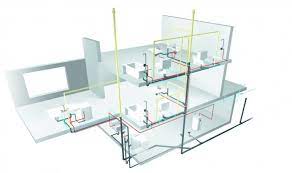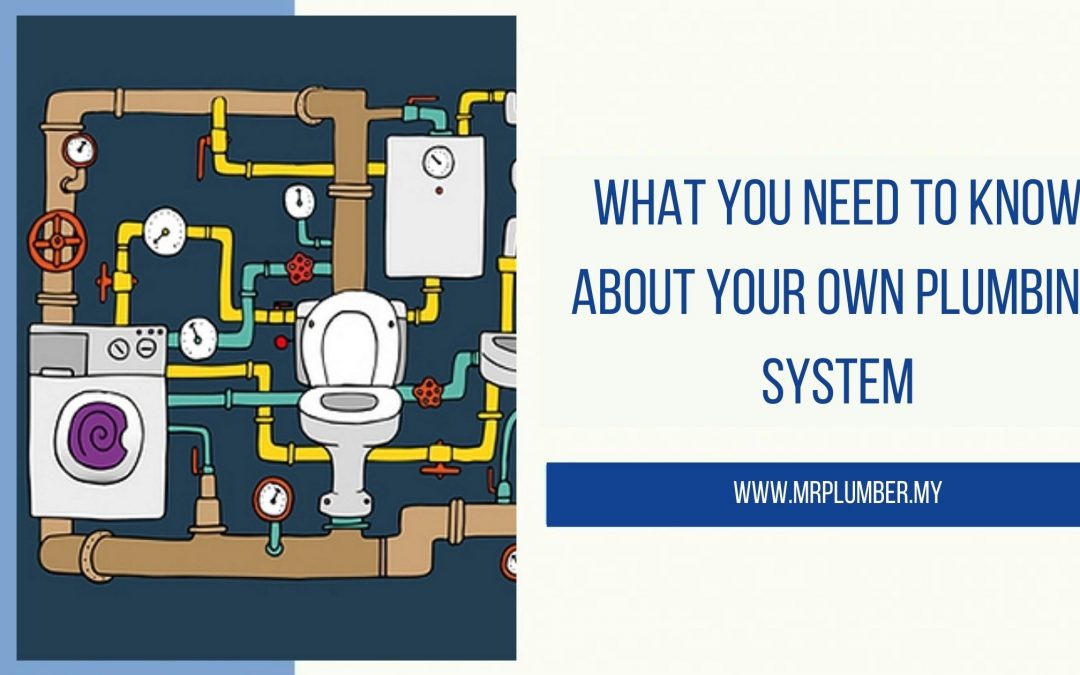To maximize the benefits of your plumbing system, it’s essential to grasp its operation. Plumbing systems encompass more than mere conduits for water transport from one location to another; they represent complex assemblies, with every element playing a crucial role in the system’s overall functionality. Navigating the intricacies of plumbing systems may seem daunting, yet gaining an understanding of how they work can prevent future issues and reduce repair costs should issues arise. This blog post aims to highlight crucial aspects of plumbing systems, enabling you to ensure your system functions optimally!
Table of Contents
What is a plumbing system?

Plumbing systems are interconnected systems of pipes, fittings, valves, and fixtures that carry water from point A to point B. Plumbing systems can be made up of a vast number of parts depending on the size and complexity.
A plumbing system is both a collective term for the many different components but can also refer directly to the pipe network itself (for example, “the plumbing system has sprung a leak”). It is also sometimes the name for a company that specializes in installing or maintaining plumbing systems.
In order to make sure your own is working properly it’s important to understand how it works!
- Pipes are used primarily for carrying water and waste, they can be made from copper pipes, steel pipes, clay tiles, or even PVC piping (which is the most common).
- Fittings are used to connect pipes together and valves can be used for turning the water on or off.
- The plumbing system also contains fixtures, which refer to any part of the system that interacts with waste such as toilets, sinks, bathtubs; these come in all shapes and sizes.
What are the benefits of understanding your plumbing system?
You might be thinking “why should I bother understanding my plumbing system when there are professionals who do this for me?”
There might be a lot of factors at play, but the most important one is that these professionals cannot keep your plumbing system running as efficiently or effectively without you! It’s true that they will often come out to fix problems with it, but if you know what is going on in your own system before the problem starts then it will be much easier for them to fix.
- The longer you go without understanding your plumbing system and all of its intricacies, the more difficult problems become when they arise. This means that any repairs or replacements that need to be done are also more costly.
- Another valuable advantage of understanding your plumbing system comes from being able to anticipate problems before they happen, which can help reduce the amount of calls you need to make about small issues that could have been fixed on their own with a little bit of attention.
It’s always worth learning more about how your plumbing system works because it ensures that you will be able to prevent problems in the future as well as better understand what is going on when they arise.
This way if something does go wrong, it’s easier for professionals to fix and also less costly!
The different components of a plumbing system
There are many different components of a plumbing system, but the main ones are pipes and fittings.
- Pipes are used primarily for carrying water and waste. They can be made from copper pipes, steel pipes or clay tiles (for example).
- Fittings connect one pipe with another to form an interconnected network that carries all sorts of fluids and matter. There are many different types of fittings used to do this, such as tees and elbows for connecting two pipes or reducers/expanders that can change the flow rate.
- Valves (sometimes called faucets) allow you to control how much water comes out into a fixture like a sink, bathtub or toilet. It’s also important to have a backflow prevention valve installed if the plumbing system has certain types of fixtures like an air gap or drip leg.
- Fixtures are parts of your plumbing system that interact with waste material and come in all shapes and sizes, from toilets to sinks and bathtubs.
There is no “standard” plumbing system and while there are some basic principles that most systems follow, the specifics can vary. This means that each one is unique to the specific property or properties it serves which requires an understanding of how things work in order for them to be maintained effectively. When it comes to the types of plumbing pipes used, there are several options such as copper, PVC, PEX, and steel. Each type has its own advantages and disadvantages, and the choice of which to use depends on factors such as cost, durability, and the specific needs of the property. Understanding the differences between these types of plumbing pipes is crucial in order to make informed decisions about installation and maintenance.
Common problems with plumbing systems and how to avoid them
From our experience as a plumbing company, there are many common problems with plumbing systems that people might not notice at first.
- Scale buildup: Over time water can pick up minerals and salts from the pipes and fixtures in your home, which will eventually cause scale to form on the inside of them. This leads to clogged drains or damaged fittings because they have difficulty moving past the scale. The best way to avoid this is by installing a water softener system that will reduce the number of minerals and salts in your plumbing system.
- Clogged drains: A clog happens when too much waste builds up over time, or material that should have been disposed of down a sink (like grease) instead finds its way into the system. The best way to avoid clogged drains is by being diligent about what goes down your sinks and toilets, and properly disposing of any wet wipes or other materials that should not be flushed.
- Pipes bursting: Burst pipes can happen for a variety of reasons. One common cause is when water freezes inside them in the winter. This can be prevented with a water supply pipe insulation system, which will keep the inside of your pipes warm enough to avoid freezing in cold weather.
- Strainer: A strainer is placed at the end of sink or bathtub drains and catches any hair that has been washed down them while also serving as a backflow prevention device. It’s important to clean these regularly so they don’t become clogged with hair, which will restrict the flow of water and can lead to other problems like a burst pipe.
- Valve malfunctions: Valves are an integral part of any plumbing system because they allow you to control how much water comes out into your fixtures (sinks, toilets, etc.). If one malfunctions and doesn’t close all the way when you turn it off, this can lead to water pressure issues in your home.
- Backflow prevention: This prevents waste from flowing back up through a fixture like an air gap or drip leg which could contaminate other parts of the plumbing system. The best way to avoid this is by making sure you install a backflow prevention valve if your plumbing system has certain fixtures.
- Electrical issues: If an electrical issue were to happen in the pipes of your home, it’s possible that there would be water damage and other serious consequences. One way to prevent this from happening is by installing ground fault circuit interrupters on any outlets that are near your plumbing system.
Steps to take if you have any problems with your plumbing system
If you have any problems with your plumbing system, or are considering installing one in your home we recommend the following:
- Talk to a professional plumber who understands how different types of fixtures work and what you need them for. This way they will be able to guide you through which type is best suited for your needs based on things like water pressure, available space, and proximity to other fixtures.
- Look for a professional who is licensed and insured, and has experience working with the type of plumbing system you need installed. This ensures that they’re knowledgeable about local codes or regulations as well as any special requirements your property may have (like existing wiring).
- Find out if there are any rebates available for the type of plumbing system you’re interested in. This will help offset the cost of installation or allow for a larger variety to choose from when deciding which type is best suited for your needs
- Consider ground fault circuit interrupters on any outlets that are near your plumbing system, so they can be avoided more easily if an electrical issue were to happen
- If you are planning to install a plumbing system in your home, make sure that there is enough space for pipes and other fixtures so they can be installed properly and not take up too much of the room. You should also plan ahead about where you’ll need drains or water supply pipe insulation as well as access points for any pipes entering and exiting the house.
Conclusion
Know how to keep your plumbing system running well by taking care of the basics. By following these simple tips, you can help prevent problems from occurring in the future and stay healthy! If you have any questions about what we’ve discussed here or if there are other things you want to know more about before making a decision on which type of plumbing service is right for your home, please don’t hesitate to reach out. We look forward to hearing from you soon!

